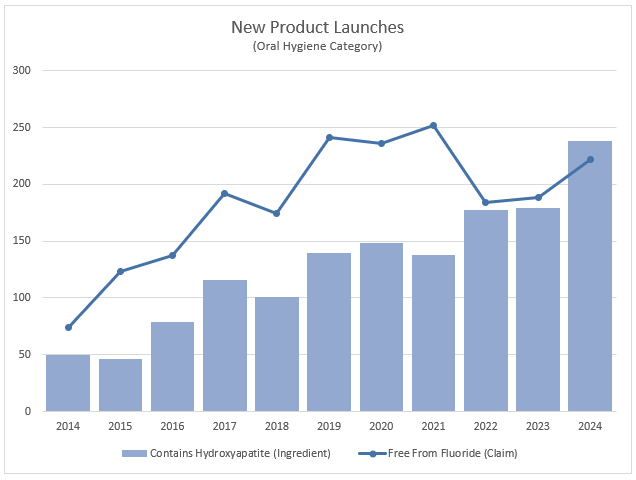February 6, 2025
National Toothache Day
February is National Children’s Dental Health Month and on the ninth day of February we observe National Toothache Day. The day, and the month of February, act as a reminder of the importance of dental health. The American Dental Association and other industry organizations create activity kits and educational material to teach children good dental hygiene practices and reinforce their importance to adults.1
Fluoride has been one of the most instrumental tools for improving oral health over the past 80 years. Early studies demonstrated that fluoridated drinking water reduced cavities by more than 60%1, and nearly 90% of toothpaste manufactured contains fluoride. Yet, dental decay continues to be one of the most common preventable diseases in adults, with 1 in 4 adults having untreated dental decay in the most recent National Health and Nutrition Examination Survey.2
Fluoride History
The protective benefits of fluoride were discovered as a result of the negative impacts of fluoride. In the early 1900s, people living in areas where the water was naturally fluoridated were observed to have brown splotchy teeth, but also had very low occurrence of dental decay.3 We now know those splotchy brown stained teeth are a sign of dental fluorosis, a condition resulting from the consumption of too much fluoride by children while their permanent teeth are still developing. We also know that the high levels of fluoride in the enamel made their teeth more resistant to acids and dental decay.
A study published in 1942, including over 7000 adolescent children from more than 20 US cities, demonstrated that children in areas with fluoridated water had fewer cavities and less severe dental decay. The authors concluded that fluoride concentrations of up to 1.0 ppm in drinking water were safe for consumption and provided a dental health benefit with a low risk for fluorosis. The first public water fluoridation project was approved in 1944, and the practice quickly became widespread throughout United States public water supplies.4
Why is Fluoride under Scrutiny?
Fluoride has been in the headlines recently, but the truth is that public water fluoridation has always been a controversial topic. Although the practice is widespread in the United States, it is estimated that less than 6% of the world population has access to artificially fluoridated water. For example, many European countries do not add fluoride to public water sources. Some countries add fluoride to milk or salt as an alternative to public water fluoridation.
Modern studies on the benefits of public water fluoridation have demonstrated a decreased benefit compared to early studies5, potentially due to overall improved oral hygiene practices and the prevalence of topical fluoride applications from daily toothbrushing and professional treatments. Furthermore, there have been studies published highlighting potential negative effects of excessive fluoride uptake. These concerns range from fluorosis to potential neurodevelopmental effects.6
Media and political sensationalism around this scrutiny has had a halo effect on topical fluoride applications as well. Many people are choosing not to use fluoride toothpaste out of fear, despite the science supporting both the safety and efficacy of topical fluoride use. The main risk of topical fluoride use is accidental ingestion of large amounts of fluoride toothpaste or mouthwash by young children. The ADA has long recommended that parents monitor their children when brushing until the child demonstrates they can spit out the toothpaste instead of swallowing it.7 Additionally, the FDA regulates the maximum amount of fluoride that can be in a tube of toothpaste, to ensure accidental ingestion of the product will not have toxic effects.8
Hydroxyapatite
Fluoride is not the only ingredient clinically proven to reduce, prevent, or repair dental decay. Hydroxyapatite, a form of calcium phosphate, forms the crystal structure of our teeth and bones. The use of biomimetic hydroxyapatite to repair dental decay was first proposed by NASA in a patent that was granted in 1972. In 1974, the rights were purchased by Japanese company Sangi Co. Ltd. Sangi launched the first toothpaste containing hydroxyapatite in Japan in 1980. In 1993, medical hydroxyapatite was approved as an active anticaries ingredient in Japan.9-10
The adoption of hydroxyapatite outside of Japan has been very slow. This is due, at least in part, to the wide availability, significant clinically documented efficacy, and low cost of fluorides compared to hydroxyapatite. Both fluoride and hydroxyapatite are clinically proven to prevent and even reverse dental decay, but hydroxyapatite is a more expensive ingredient and requires higher usage levels. There are also other calcium-based remineralization technologies, such as Recaldent® and NovaMin, but these are not available to most manufacturers due to active patent protections.

Figure 1: Graph of new oral hygiene products cataloged in Mintel NPD between January 1, 2014 and December 31, 2024 featuring either (a) the ingredient hydroxyapatite or (b) a “free from fluoride” or “fluoride-free” claim.11
Fluoride-free toothpastes have been widely available for decades and are featured prominently in the natural toothpaste segment. For many years, the majority of these products did not contain any ingredient clinically proven to reduce or prevent dental decay but instead relied on the user effectively removing the plaque biofilm from their teeth with daily brushing. There is a growing demand for products containing hydroxyapatite as an alternative to using fluoride toothpaste. Review of the Mintel New Products Database shows that the number of new oral hygiene products introduced with a “free from fluoride” claim has remained relatively steady since 2017, whereas the number of new products featuring hydroxyapatite as an ingredient has been steadily growing over the same time period. In 2024, the number of products featuring hydroxyapatite exceeded the number of products with “free from fluoride” claims for the first time.11 Considering the current sentiment around fluoride, it seems likely that both these will grow over the coming years.
Conclusion
Public water fluoridation may be under serious scrutiny, but most dentists and researchers still agree that daily tooth brushing with a fluoride toothpaste is both safe and an effective way to reduce dental decay. For those who prefer not to use fluoride, whether due to concerns about health and safety, a penchant for natural or environmentally friendly products, or any other reason; it’s ideal to seek out a product with hydroxyapatite or another clinically proven remineralizing ingredient. Click here to learn more about Omyadent® 100 for remineralization.
References
- National Childrens Dental Health Month | American Dental Association. www.ada.org. https://www.ada.org/resources/community-initiatives/national-childrens-dental-health-month.
- National Institute of Dental and Craniofacial Research. Dental Caries (Tooth Decay) in Adults (Age 20 to 64) | National Institute of Dental and Craniofacial Research. Nih.gov. https://www.nidcr.nih.gov/research/data-statistics/dental-caries/adults.
- National Institute of Dental and Craniofacial Research. The Story of Fluoridation | National Institute of Dental and Craniofacial Research. Nih.gov. https://www.nidcr.nih.gov/health-info/fluoride/the-story-of-fluoridation.
- CDC. Timeline for Community Water Fluoridation. Community Water Fluoridation. https://www.cdc.gov/fluoridation/timeline-for-community-water-fluoridation/index.html.
- Iheozor-Ejiofor, Z., Walsh, T., Lewis, S. R., Riley, P., Boyers, D., Clarkson, J. E., Worthington, H. V., Glenny, A. M., & O’Malley, L. (2024). Water fluoridation for the prevention of dental caries. The Cochrane database of systematic reviews, 10(10), CD010856. https://doi.org/10.1002/14651858.CD010856.pub3
- Choi AL, Sun G, Zhang Y, Grandjean P. Developmental fluoride neurotoxicity: a systematic review and meta-analysis. Environ Health Perspect. 2012 Oct;120(10):1362-8. doi: 10.1289/ehp.1104912. Epub 2012 Jul 20. PMID: 22820538; PMCID: PMC3491930.
- Dear Dental Professional. https://www.ada.org/-/media/project/ada-organization/ada/ada-org/files/resources/public-programs/give-kids-a-smile/ada-gkasts-eng_dental_professionals.pdf.
- 21 CFR 355.20 — Packaging conditions.gov. https://www.ecfr.gov/current/title-21/chapter-I/subchapter-D/part-355/subpart-B/section-355.20 (accessed 2025-02-05).
- Semiconductor Research Leads to Revolution in Dental Care | NASA Spinoff. spinoff.nasa.gov. https://spinoff.nasa.gov/Semiconductor_Research_Leads_to_a_Revolution_in_Dental_Care.
- MILESTONES. SANGI CO.,LTD. https://www.sangi-co.com/en/history/index.html (accessed 2025-02-05).
- Nesta, J. (2025, July). New Products Database search. Mintel.
